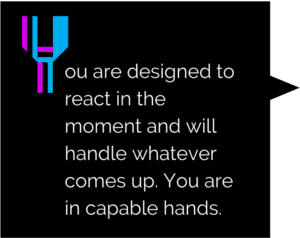Reframing
A Robot's Guide To Worry Part 2: Reframing
Welcome to Part 2 of our series. In this part and the next, we will be covering techniques to help you neutralize unproductive worries (worries that provide no value, that are not actually helping you resolve or prepare for anything). Then in Parts 4 and 5, we will address circumstances where you cannot so easily dismiss your worries, where you find yourself concerned about an issue that does require further thought or a decision to be made. For these situations, we will cover techniques to improve your problem-solving and help you make your worries more productive.
Techniques To Help Neutralize Worry
We will focus on two main techniques to help us deal with unproductive worries: reframing and defusion. In this part we will cover reframing, in the next, defusion. Reframing has to do with making a conscious effort to change our thoughts in an attempt to refute and neutralize the worry. Defusion, on the other hand, is based on the notion that it is very difficult to consciously control our thoughts and provides us with a method to allow our worries to be present but yet dampen their effect on our lives. You may notice that these techniques seem to contradict one another; one suggests that we can convince ourselves not to worry, whereas the other starts with the notion that it is quite difficult to make our worries go away. Despite their opposite nature, these can be used in a complementary way and will provide you with both a yin and yang for your mental toolkit.
Reframing is a common technique that simply means you are making a deliberate, conscious effort to change the way you see a situation. In its most simple form, reframing involves taking a situation that initially evokes a negative mindset and purposefully changing the way you look at it to put on a more positive spin. Reframing will be your first line of defense against unproductive worries. Reframing a worry often involves presenting the case to yourself that you do not need to be worried about the issue at hand. This usually takes the form of thinking about all of the reasons that this negative thing will likely not occur, and that if it does, you will take it in stride.
We will focus on two main techniques to help us deal with unproductive worries: reframing and defusion. In this part we will cover reframing, in the next, defusion. Reframing has to do with making a conscious effort to change our thoughts in an attempt to refute and neutralize the worry. Defusion, on the other hand, is based on the notion that it is very difficult to consciously control our thoughts and provides us with a method to allow our worries to be present but yet dampen their effect on our lives. You may notice that these techniques seem to contradict one another; one suggests that we can convince ourselves not to worry, whereas the other starts with the notion that it is quite difficult to make our worries go away. Despite their opposite nature, these can be used in a complementary way and will provide you with both a yin and yang for your mental toolkit.
Reframing is a common technique that simply means you are making a deliberate, conscious effort to change the way you see a situation. In its most simple form, reframing involves taking a situation that initially evokes a negative mindset and purposefully changing the way you look at it to put on a more positive spin. Reframing will be your first line of defense against unproductive worries. Reframing a worry often involves presenting the case to yourself that you do not need to be worried about the issue at hand. This usually takes the form of thinking about all of the reasons that this negative thing will likely not occur, and that if it does, you will take it in stride.
For example, if you are worried about an upcoming presentation at work, you may remind yourself that all of your previous presentations have been well-received and that even if this upcoming one is not, no great disaster will occur. Perhaps you will feel self-conscious, but you will not lose your job, and everything will end up fine. This way of reframing your thoughts is likely quite familiar to you and is something you may naturally do all the time. Despite this not being a new technique for you, it is worth taking a moment to examine here.
Recall that much of what goes on in our conscious mind is not consciously authored or chosen. Much of what we find ourselves thinking about is pumped up from below, generated by unconscious processes. This creates an autopilot-like quality to the way we look at many situations. When a worrying thought pops up, it is natural for us to go through the mental motions and indulge the assignment. So often, our thoughts will move along, and we will not think to question whether we might be better off looking at the situation differently.
For these reasons, putting some thought into the concept of reframing is important because it will help you be more deliberate. It will help you to recognize the autopilot-like nature of your worries more often and remind you to engage in this process of shifting your thinking. The arguments you create to convince yourself not to worry need not be complex. You needn’t think of yourself as a trial lawyer presenting every last shred of evidence. This technique is more about being mindful of your own thought process. You want to become quicker at recognizing the autopilot-like progression of worry, snapping out of it, and then redirecting your thoughts.
Aside from presenting arguments specific to the issue at hand, such as in the above example about giving a presentation at work, there are some effective general-purpose reframes that you can use for worry. When a new worry pops into your head, begin by simply asking yourself if the worry is productive? Will further thought right now help resolve anything? If the answer is no, there are many ways to strengthen the case that you don’t need to engage the assignment. Here are some examples:
The Serenity Reframe
A quick way to rule a worry as unproductive is to ask yourself if the situation is within your control. So often it is not. As previously mentioned, our caveman brains, running on autopilot, frequently get stuck worrying about circumstances over which we have no influence. Be on the lookout for these types of situations. Many of you will be familiar with the serenity prayer. Remind yourself of it often: “Grant me the serenity to accept the things I cannot change, courage to change the things I can, and wisdom to know the difference.”
The Future Self Reframe
When you find yourself wrapped up in stress and worry, ask yourself what advice your future self would give you. Imagine that you were able to talk to yourself ten years into the future about whatever is currently stressing you out. Does your future self think the situation is a big deal? Does the outcome matter to them? Do they even remember this particular situation? When you suspect you might be taking things too seriously, this perspective shift can help you let go and move on with your day.
The Uncertainty Reframe
Another good general-purpose reframe for worry is to remind yourself that it is impossible to remove all uncertainty in most situations. Often, we find ourselves worrying because we are trying to cover every eventuality and have a plan for every possible thing that could go wrong. Uncertainty is uncomfortable, but so often there is nothing we can do to remove it.
Many of us use worry as a coping strategy to help us deal with uncertainty. It is often better to resist this temptation and instead focus on accepting uncertainty. Instead of helping, worrying about everything that could go wrong will tend to perpetuate cycles of negative thinking that will hold you back and discourage you from taking the bold action that you might otherwise be inclined towards.
temptation and instead focus on accepting uncertainty. Instead of helping, worrying about everything that could go wrong will tend to perpetuate cycles of negative thinking that will hold you back and discourage you from taking the bold action that you might otherwise be inclined towards.
This coping strategy of worry can be appealing because it provides the illusion of control; it makes us feel as though we are doing something to help. Most often, though, worrying about every little thing that could go wrong will only serve to throw fuel on the fire by causing your concerns to spiral. We begin by worrying that we will screw up the presentation, we then start worrying that we will lose our job, and before you know it, we are indulging nightmare scenarios where we lose our home and our whole world has crumbled.
We all want to be calm and confident, and for many of us, trying to eliminate uncertainty seems like a way to help get there. However, it is important to realize that those people who we admire for having these desirable traits have not obliterated all negative thoughts and emotions from their lives. No matter how much self-development work you do, you will always have some down days and negative thoughts. Those we admire for their steadfast demeanor are able to carry on with composure despite this inner turmoil and uncertainty. When you find yourself wrapped up in unproductive worry, remind yourself that uncertainty is a part of life. Practice accepting this and calmly going on with your day despite it. Bring to mind that person or character you admire. Channel their energy.
The Faith Reframe
Can you think of a time when you found yourself in an urgent situation, and you were amazed at how you rose to the occasion? You likely have a long history of doing what needs to be done when challenging circumstances arise. And you can undoubtedly think of many, many times when you had worried quite a bit about some looming problem, only to look back on it and realize that the time spent worrying was much worse than the challenging situation itself.
To plan, scheme, worry, and imagine worst-case scenarios are all within the department of the Conscious Thinking System. Acting and deciding in the moment, however, largely falls to the Supercomputer (recall that Supercomputer is the term we are using to describe the collection of our unconscious systems). The Conscious Thinking System is too slow and cannot process near enough information at once to produce a coordinated response in a short period of time. Even natural conversation occurs too quickly for the Conscious Thinking System to play a big role; we typically respond with what pops into our head from below. Many of the situations that you worry about end up being handled by the Supercomputer. Have faith in it. Have faith in yourself. 
When you find yourself locked up with unproductive worries, remind yourself that your Conscious Thinking System isn’t in this alone and doesn’t need to prepare for every possible thing that could go wrong. Your Unconscious Supercomputer is designed to react in the moment and will handle whatever comes up. You are in capable hands. And in the case of unproductive worries, thinking about it more ahead of time isn’t going to help the Supercomputer do its job. You are more robotic than you realize. Relax and let things happen. In these situations, you are going to react and do what you do when you get there, regardless of how much you worry ahead of time.
This, of course, is not a guarantee of a positive outcome, but in a case where you are bogged down in unproductive rumination, it’s important to acknowledge that the result will not be better with more worry. You can only do what you can do. You will take reasonable precautions, you will meet the challenge to the best of your ability, and you will let the chips fall where they may. This is all you can ask of yourself. If things do not turn out well, you will learn from the experience. You will try to see adversity as an opportunity for growth.
Worrying about an upcoming conversation often fits into this category. Relax and have faith in yourself. Sure, it can be a good idea to put a little thought into a potential confrontation before finding yourself in it, and yes, rehearsal can be beneficial. That said, these situations can quickly cause us to run aground in the realm of unproductive worry, obsessively ruminating over and over. You can’t prepare for every twist and turn the conversation could potentially take. You will say what you say when you get there. You are designed to do this on-the-fly. Have faith in yourself. You are much more capable than you consciously realize.
To Be Continued
The above techniques can be quite helpful; however, despite our best efforts to reframe and convince ourselves not to worry, negative thoughts will often keep bubbling up. In the next part of this series, we will examine the tool of defusion, our go-to when our efforts to reframe are not enough.
